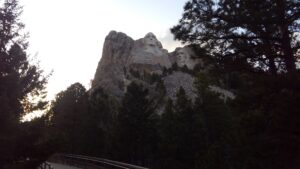Last spring, my son AJ and I took a trip out west. We visited Mt. Rushmore in the Black Hills of South Dakota, Devil’s Tower, and drove through the Bighorn Mountains in Wyoming. It was quite an experience for this Midwest girl from the Driftless Area with its gentle little hills. Each of these formations was a massive igneous eruption bursting through the flat sedimentary rock layers under the western prairies.
I did some research before going on the trip to discover what the difference between basalt and granite was and where they come from.
They are both liquid rock at first, below the crust of the earth that is between five and twenty-five miles thick. Basalt cools quickly; it is the rock that come up in volcanoes to cool suddenly at the surface. It cools so fast that often the different minerals in a basalt rock are so tiny their crystals can only be seen under magnification. Granite, on the other hand, cools slowly, far down near the liquid mantle layer. The granite mountains we see have been pushed up to the surface as semi-solid rock. Because they cool slowly, the different minerals in them (feldspar, quartz, mica, etc.) solidify at different rates, depending on the melting temperature of each mineral. That is why granite has that speckled look. It is the difference between taking eggs out of boiling water to put them immediately into ice water, and leaving the eggs to cool as the boiling water cools; anyone who has ever hard-cooked eggs knows there is a vast difference in the outcome, though they are both still eggs.
So here we were at Mt. Rushmore. The mountains of the Black Hills are granite formed deep in the crust and forced up through the sedimentary layers that were laid down in the first stage of the Flood. Right under Washington’s head, you can see the granite bending at a 45 degree angle.

Rocks don’t bend, they break, except when they are still plastic, still hot enough to bend. The Bighorn Mountains are a bigger version of the Black Hills but it is notable that as you go up the east side of the range, the rock is granite and when you go down the west side of the range, the rocks are sedimentary lime- and sandstone.

(Sedimentary rocks on the west side of the Bighorn Mountains.)

(Sylvan Lake at Custer State Park in the Black Hills. These rocks are granite and very like the rocks on the east side of the Bighorn Mountains.)
One can see vividly the hot, plastic granite being forced up from deep in the earth’s crust through the soft sedimentary layers that had not yet solidified during the year of the Flood. In the same way, Devil’s Tower is comprised of basalt columns exploding through the surrounding sedimentary rock.

(Devil’s Tower National Monument, Wyoming)
AJ and I sat on the knees of Devil’s Tower and I tried to get my head around what had happened there. In the Driftless Area, we look out over rich, gentle hills covered with forests and fields and I see God’s love in his kindness and generosity.

(River valley at Base Camp USA, Mineral Point, Wisconsin)
I look out at the wreckage of the earth in the Bighorns, Black Hills, and Devil’s Tower and I see His wrath. He hated Man’s sin so much that He tore the earth apart, turned it inside out. But in that wrath, I also see His love. We are His, His very own special creation, made in His own image, and He wants a relationship with us and hates anything that turns us away from Him, including our own sin. Modern theology tells us that wrath, as wrath, is not consistent with a loving God. But just as we would not find it inconsistent for a loving parent to strongly discipline a child who had run into the street, an action that threatens to take a child away from his parents if he gets hit by a truck, neither is it inconsistent for a loving God to hate the actions of His children when we choose to do things that threaten our relationship with Him, such as violence, selfishness, lust, and hate.
So, after all, I look at the colossal wrecks of mountains in the west and what wrath God showed during the global Flood, and I see His surpassing love for us in tearing the earth apart in His anger at man’s sin and to give us a fresh start; in the gentle Driftless Area, I see His kindness and generosity and His willingness to die Himself to save us from it.


Leave a Reply